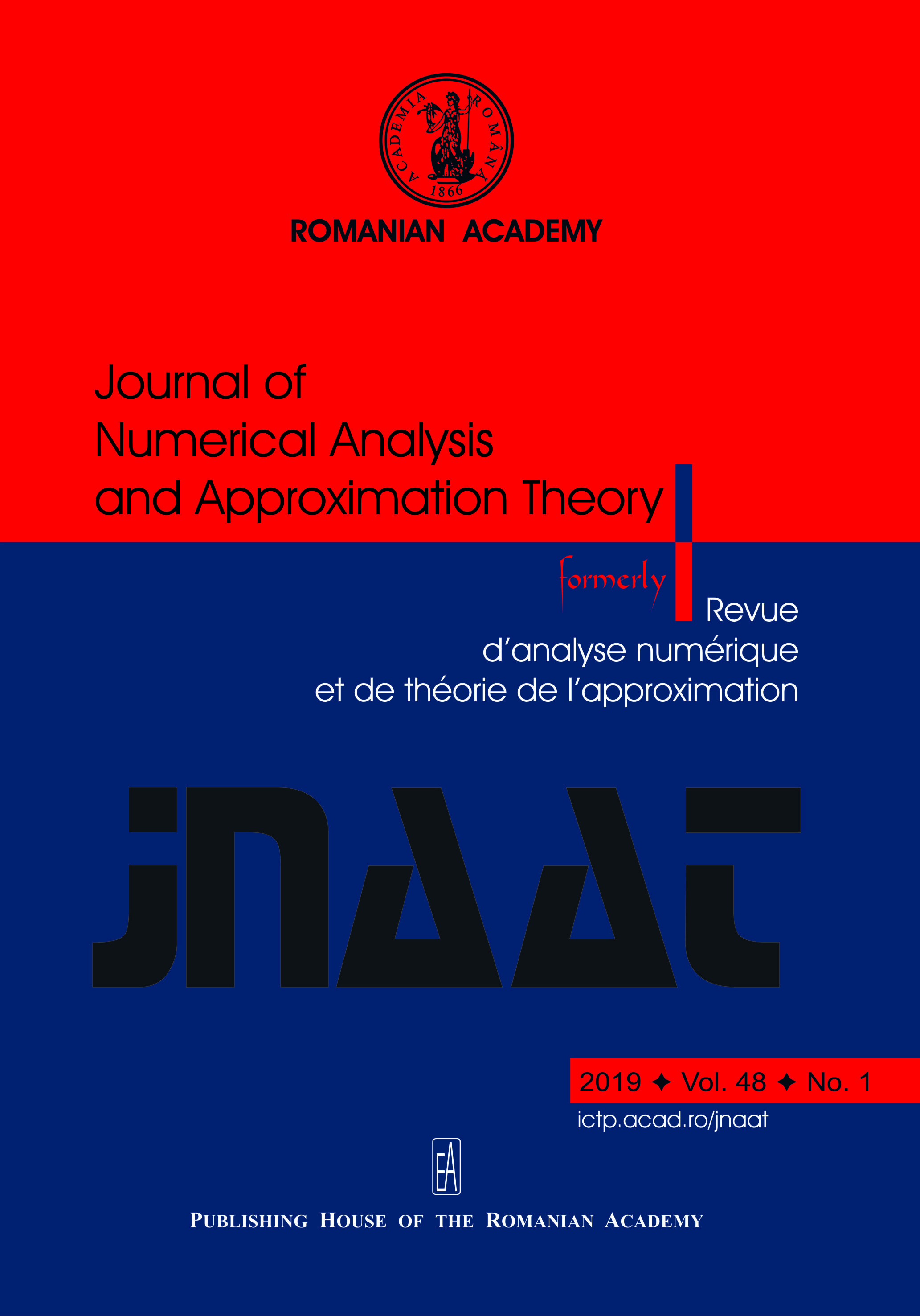On Berman's phenomenon for (0,1,2) Hermite-Fejér interpolation
DOI:
https://doi.org/10.33993/jnaat481-1163Keywords:
interpolation, polynomial interpolation, Hermite–Fej´er interpolation, Chebyshev nodes, Berman’s phenomenonAbstract
Given \(f\in C[-1,1]\) and \(n\) points (nodes) in \([-1,1]\), the Hermite-Fejer interpolation (HFI) polynomial is the polynomial of degree at most \(2n-1\) which agrees with \(f\) and has zero derivative at each of the nodes. In 1916, L. Fejer showed that if the nodes are chosen to be the zeros of \(T_{n}(x)\), the \(n\)th Chebyshev polynomial of the first kind, then the HFI polynomials converge uniformly to \(f\) as \(n\rightarrow\infty\). Later, D.L. Berman established the rather surprising result that this convergence property is no longer true for all \(f\) if the Chebyshev nodes are augmented by including the endpoints \(-1\) and \(1\) as additional nodes. This behaviour has become known as Berman's phenomenon. The aim of this paper is to investigate Berman's phenomenon in the setting of \((0,1,2)\) HFI, where the interpolation polynomial agrees with \(f\) and has vanishing first and second derivatives at each node. The principal result provides simple necessary and sufficient conditions, in terms of the (one-sided) derivatives of \(f\) at \(\pm 1\), for pointwise and uniform convergence of \((0,1,2)\) HFI on the augmented Chebyshev nodes if \(f\in C^{4}[-1,1]\), and confirms that Berman's phenomenon occurs for \((0,1,2)\) HFI.
Downloads
References
D.L. Berman, On the theory of interpolation, Dokl. Akad. Nauk SSSR, 163 (1965), pp. 551–554 (in Russian). [Soviet Math. Dokl., 6 (1965), pp. 945–948]
D.L. Berman, An investigation of the Hermite–Fejer interpolation process, Dokl. Akad. Nauk SSSR, 187 (1969), pp. 241–244 (in Russian). [Soviet Math. Dokl., 10 (1969), pp. 813–816]
R. Bojanic, Necessary and sufficient conditions for the convergence of the extended Hermite–Fejer interpolation process, Acta Math. Acad. Sci. Hungar., 36 (1980), pp. 271–279, https://doi.org/10.1007/bf01898143 DOI: https://doi.org/10.1007/BF01898143
G.J. Byrne, T.M. Mills and S.J. Smith, On Hermite–Fej´er type interpolation on the Chebyshev nodes, Bull. Austral. Math. Soc., 47 (1993), pp. 13–24, https://doi.org/10.1017/S0004972700012223 DOI: https://doi.org/10.1017/S0004972700012223
W.L. Cook and T.M. Mills, On Berman’s phenomenon in interpolation theory, Bull. Austral. Math. Soc., 12 (1975), pp. 457–465, https://doi.org/10.1017/S0004972700024114 DOI: https://doi.org/10.1017/S0004972700024114
G. Faber, Uber die interpolatorische Darstellung stetiger Funktionen, Jahresber. Deutsch. Math.-Verein., 23 (1914), pp. 190–210.
L. Fej´er, ¨ Uber interpolation, Gottinger Nachrichten, (1916), pp. 66–91.
N. Krylov and E. Steuermann, Sur quelques formules d’interpolation convergentes pour toute fonction continue, Bull. Sci. Phys. Math. Acad. Sci. Ukraine, 1 (1922), pp. 13–16.
M. Maky, On an extended Hermite–Fejer interpolation process, Journal of al-qadisiyah for pure science [Al-Qadisiyah University, Iraq], 13 (2008) no. 2, pp. 1–8.
L. Neckermann and P.O. Runck, Uber Approximationseigenschaften differenzierter Lagrangescher Interpolationspolynome mit Jacobischen Abszissen, Numer. Math., 12 (1968), pp. 159–169, https://doi.org/10.1007/bf02162908 DOI: https://doi.org/10.1007/BF02162908
T.J. Rivlin, An introduction to the approximation of functions, Dover, New York, 1981.
T.J. Rivlin, Chebyshev Polynomials: From Approximation Theory to Algebra and Number Theory, 2nd ed., Wiley, New York, 1990.
J. Szabados and A.K. Varma, On (0, 1, 2) interpolation in uniform metric, Proc. Amer. Math. Soc., 109 (1990), pp. 975–979, https://doi.org/10.1090/s0002-9939-1990-1013983-x DOI: https://doi.org/10.1090/S0002-9939-1990-1013983-X
J. Szabados and P. Vertesi, Interpolation of Functions, World Scientific, Singapore, 1990. DOI: https://doi.org/10.1142/0861
Published
Issue
Section
License
Copyright (c) 2019 Journal of Numerical Analysis and Approximation Theory

This work is licensed under a Creative Commons Attribution 4.0 International License.
Open Access. This article is distributed under the terms of the Creative Commons Attribution 4.0 International License, which permits unrestricted use, distribution, and reproduction in any medium, provided you give appropriate credit to the original author(s) and the source, provide a link to the Creative Commons license, and indicate if changes were made.










